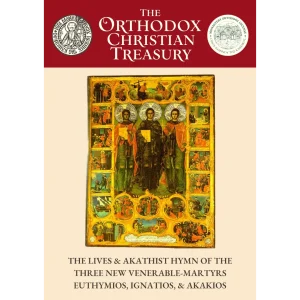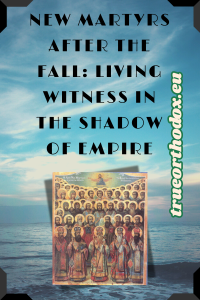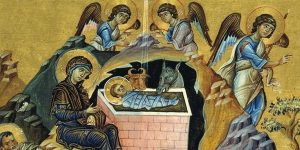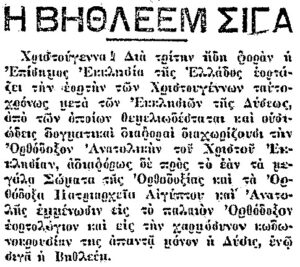The Church of the Martyrs by Archbishop Anthony (Sinkevich) (+1996) of Los Angeles
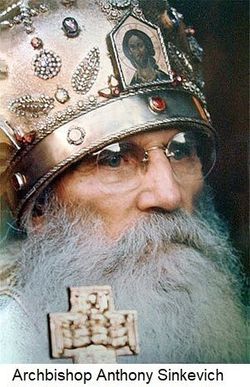
A report by Archbishop Anthony of Los Angeles, compiled in fulfilment of the decree of the Synod of Bishops dated 9/22 March 1972, concerning the collection of materials pertinent to the glorification of the Assembly of New Martyrs of Russia.
l. Veneration of the holy martyrs in the ancient Church and the Greek Church today.
In the belief of the ancient Christian Church, the feat of martyrdom alone and of itself establishes sanctity, as the Church triumphantly proclaims in the troparion to the martyrs, who “in their suffering acquired incorruptible crowns,” not from men, but “from God.” This the Church confesses in the Sunday antiphons of the second tone: “All wisdom floweth from the Holy Spirit, whence grace comes unto the apostles, martyrs are crowned by sufferings, and the prophets see” (Third antiphon).
In the ancient Church the holy martyrs and their holy relics were venerated from the moment of their decease; if it was feasible, churches were raised in honor of them immediately after they were killed, as, for example, to the holy First. Martyr Stephen, the holy Greatmartyr George, the holy Greatmartyr Barbara, the holy Greatmartyr Nicetas, the holy martyr Agatha, the holy martyr Agnes, the holy martyr Agrippina, the holy martyr Boniface, the holy martyr Hieron, the holy martyr Eupraxia, the holy martyr Julian, the holy martyr Conon, the holy martyrs Manuel, Sabel and Ismael, the holy Forty-Five Martyrs in Nicopolis, of Armenia, and to others. (All information is taken from the Lives of the Saints of St. Dimitri of Rostov). These churches were often built by ordinary laymen.
In the Greek Church, not only the ancient martyrs, but also the new ones are acknowledged as saints and are to be venerated as such, even without a canonical inquiry of the Church, precisely as the ancient Church looked upon her first martyrs, i.e., she accepted them as saints for their very martyric death, not establishing the gift of miracle-working as an indispensable condition, which is generally required of other types of saints.
Among the Greek martyrs are not a few that had apostatized to Islam, who later returned to Christianity and strove to redeem their sin of apostasy by martyrdom. In the Greek Church at the beginning of the nineteenth century a full schism over the martyric end of one such lapsed occurred between those that acknowledged him to be a saint and those that did not. The then Patriarch of Constantinople, Gregory V (a well-known martyr who suffered in 1821), with a synod of bishops, solemnly confirmed the commonly accepted view of these martyrs as perfect martyrs. In view of the fact that the greater part of these new Greek martyrs, not officially canonized, do not have their own services, there exists in the Greek Church a common service for them (E. Golubinsky, On the Canonization of Saints in the Greek Church, pp. 26 & 27).
The Hieromartyr Cyprian of Carthage (3rd cent.) admonishes all Christians to see to it that after death the bodies of the martyrs are accorded due respect (Lives of the Saints, August, p. 593). In another place he confirms the early Christians’ practice of recording accurately the days of the deaths of the holy martyrs and of gathering on these days for the celebration of their memory. “Note the days on which the confessors of Christ die, that we may be able to celebrate their memory together with the memory of the martyrs” (Lives of the Saints, September, p. 5).
2. Why does the holy Church venerate the martyric struggle so highly?
It is necessary to consider why the martyric struggle especially has always been so highly valued by the holy Church, that it is sufficient for the attainment of sanctity even in the presence of sins, often grave, which the holy martyrs would sometimes have up until martyrdom, as for example the holy martyr Boniface (commemorated 19 December), who lived. in an illicit liaison with Aglaida almost up to his very martyrdom. St. Dimitri of Rostov writes about him: “His unclean acts were washed away by the pouring out of his blood, and thereby his soul was made as royal purple and was crowned with the crown of martyrdom.” Similar were the seven bandits (Saturninus, Jakischolus, Faustianus, Januarius, Marsalius, Euphrasius and Mammius), who were in prison and converted to the faith by the holy apostles Jason and Sosipater. They died martyrically for the faith and received crowns from the Lord, Their memory is 28 April.
The word “sufferer” (“muchenik”), by which the Slavs translated the Greek word “martyros” — “witness,” gives only the secondary outline of the fact; in martyrdom the Slavic peoples were most of all struck by the tortures of the martyrs, and not by their witness for the faith. The ancient Church saw it otherwise. Martyrs are champions of the faith, and their martyrdom an active exploit. The holy martyrs accomplished their feat with the purpose of witnessing before those who are in error about the faith, about the true God, about Christ, and by their own blood they confirmed their testimony, showing that there is an eternal life and a heavenly kingdom, which is more precious than temporal life.
The height of the feat of martyrdom was also evidenced by the fact that the Lord Jesus Christ Himself was pleased to call Himself the “faithful Witness”, (Rev. 1:5; 3:14) and he also called the martyrs and the apostles by this word, “witness,” (Rev. 11:13; Acts 1:8, 22:18; Jn. 15:26-27). The Apostle Paul calls the First-Martyr Stephen a “witness” of the Lord Jesus Christ (Acts 22:20), and the apostles call their own preaching activity, “witness” (Rev. 1:2; Acts 22:15). In this manner the martyrs were preachers of Christianity and were the continuers of the apostolic ministry in the world.
The holy Church also places on the same height those martyrs who did not succeed in confessing the truth of Christ by word, but confessed it only by their own blood, as for example, the 14,000 martyrs for Christ killed by Herod, and other holy martyrs killed, burned or beheaded for Christ and with whom the persecutors did not converse, killing them only because they were Christians, many of whom we find in the lives of the saints,
The powerful action of the martyric struggle on the human heart is expressed by Tertullian in the words, “the blood of Christians is the seed” of the new life in Christ, and this is an historical fact. Was it not for this reason that both ancient and modern persecutors of Christianity have regarded with such fear the influence of this exploit drawing many to the faith, who frantically tried to destroy the bodies of the holy martyrs, as they have destroyed the bodies of the murdered members of the Royal Family, hoping thereby to annihilate their very memory? (A significant portion of this explanation is taken from the book of Prof. V. Bolotov, Lessons in the History of the Ancient Church, Vol. IL, pp. 2-9).
We confess belief in “One, Holy, Catholic and Apostolic Church.” One would think that on account of the very close similarity of the martyric exploit to the apostolic, and of which it is a continuation, the holy martyrs are often placed in liturgical texts immediately after the apostles, and higher than other kinds of saints. For example, apostles, hierarchs, and martyrs in the Liturgy of St. John Chrysostom, are commemorated at the proskomedia, and after the consecration of the Holy Gifts, the priest prays, “Yet again we offer this rational service for those who have fallen asleep in the faith: for the forefathers, fathers, patriarchs, prophets, apostles, preachers, martyrs, confessors, ascetics, and for every righteous soul reposed in the faith.”
In the 4th Oikos of the Akathist to the Mother of God we find, “Rejoice, never-silent voice of the apostles; rejoice, never-conquered courage of the martyrs!
The last verse of the eighth prophetic ode of the canon: “Bless the Lord, ye Apostles, Prophets and Martyrs of the Lord: O praise ye the Lord and supremely exalt him unto the ages.” This same verse is read at the scriptural reading on Great Saturday.
The penultimate troparion before “Glory to the Father…” at the small blessing of water: “Through the prayers of the glorious apostles and martyrs, and all Thy saints, grant Thy mercies unto Thy people….”
In the prayer at the lity, “O Lord, save…,” repeated at matins, the martyrs are commemorated at the end of the other ranks of saints, however, the enumeration of saints in this prayer is of late development. In the most ancient Greek manuscripts, those of the 13th century, only the Theotokos, the Cross, the Forerunner, the apostles, the saint of the day, “and all the saints,” are commemorated. In the Slavonic manuscripts of the 15th century, the archangels and the “rightly-triumphant holy martyrs” were added. The Service Book (Sluzhebnik) of Metropolitan Peter Mogila (17th century) places the martyrs and monastic saints right after the apostles, but in the Moscow Service Book of 1658, martyrs and monastic saints were placed before hierarchs. And in later times the commemoration and number of saints in this prayer constantly changed (M. Skaballanovich, Annotated Typicon, 2nd ed., pp. 171-174). Today this prayer has three different redactions: the Kiev, Moscow and Pochaev editions. The place of martyrs in the prayer at the Lity in its present form constitutes a deviation from the ancient order.
The Orthodox Church on weekdays and Saturdays dedicates many hymns (stichera, sessional hymns, and canon troparia) to the holy martyrs in contradistinction to other kinds of saints, a fact which shows their exalted rank in the Church of Christ, and she prays to them as to ones having a special gift of prayer for us (“for to you hath been given the grace to pray for us”). All this confirms the Church’s faith in the special sanctity of the martyric feat. The absence of the names of the martyrs in these services would allow us to suppose that here are implied all the holy martyrs who have suffered for Christ, including those whose names are not written in the menology, which is completely in accord with the belief and practice of the Church from the most ancient times.
The holy martyrs are glorified before other saints with special solemnity, in hymns and in special prayers at the time of the consecration of a church.
Keeping in mind the continuation of the apostolic ministry by the holy martyrs and the great reverence paid to their struggle by the holy Church, one may understand profoundly that our holy Church, while apostolic, is at the same time martyric, or the “Church of the Martyrs.” This also follows from the simple comparison of the number of glorified holy martyrs, indicated in the complete menology of the Orthodox Church — about 350,000 — with the number of all the rest of the saints — about 12,000, i.e. for every thirty holy martyrs, there corresponds approximately one saint of another rank.
3. Why is the glorification of the holy New Martyrs of Russia necessary?
In the face of the unprecedented persecutions and sufferings of our believing brothers in enslaved Russia, where human help is powerless, it is possible to improve the situation only with heavenly help through the prayers of the holy martyrs, whose glorification will also definitely surround us by their prayers. Such a way of obtaining heavenly intercession in our times of unprecedented shocks, sufferings, and change is especially appropriate in view of the example of the Stoglav Council of 1551, whose main purpose was the spiritual renovation of the Russian Church, which had taken the first place among the other Orthodox Churches after the fall of Byzantium.
But before undertaking the renovation of the Church, Metropolitan Makary of Moscow first took care of another matter. The foundation and glory of every Church is her saints. Desiring to undertake the renovation of the Church with the aid of all the Russian wonderworkers, Metropolitan Makary began with a general solemn glorification of those of them that had remained unglorified, or not sufficiently venerated. At two Councils, in 1547 and 1549, the metropolitan canonized thirty-nine saints, nine of whom had been formerly glorified; of the remaining thirty, twenty-two were locally celebrated saints, for whom celebration by the entire Church was now appointed, and eight for whom local celebration was established, through their introduction into the Menology. (Prof. E. Golubinsky, History of the Canonization of Saints in the Russian Church, p. 92-109).
4. Resolution of the Pan-Russian Council and of the Synod of Bishops on the glorification of martyrs.
The first Pan-Russian Sacred Council on 5/18 April 1918 published a decision “On procedures, occasioned by the current persecution of the Orthodox Church,” the third point of which reads: “in all parishes, where there were confessors and martyrs who ended their course in life for the Faith, and for the Church, to organize processions to the places of their burial, there to serve solemn memorial services with the glorification of their sacred memory in a homily.”
In this decision attention must be given to the unusual expression — “ended their life,” in place of “killed,” as though the martyrs of their own will finished their life and that no one else was to blame for it. This is explained by the danger of retaliations if the murderers holding power were named. One cannot but notice the one contradiction in this decision. It is prescribed to “glorify their sacred memory,” but to glorify merely “in word,” and at the same time, in place of prayers to the holy martyrs. for glorification consists precisely in this. It is prescribed to serve only solemn requiems. This part of the decision is easy to understand in the absence of freedom of the Church and in face of the future flame of persecutions and of the torrents of blood of the revolution. In the ancient Church, for the most part, the holy martyrs could not be fully glorified during the powerful persecutions, for example under Nero (1st century), Decius (3rd century), or Diocletian (beginning of the 4th century), but soon after the cessation of these persecutions, churches were built in their honor, which served, as it were, as their glorification. Besides, the building of churches is not a necessary part of the glorification, representing as it does but one of the evidences of that glorification which has already occurred.
In this manner, therefore, and by this decision what was possible under the then threatening circumstances was done for the glorification of the holy martyrs, viz: the high endeavor of the martyrs was acknowledged, and the desire was expressed for the “glorification of their memory.”
And so, finding ourselves in conditions of complete freedom, we are able, and morally obligated, to glorify the sacred memory of all the holy new martyrs as it should be, viz., to establish a celebration for them.
On 9/22 September 1971 the synod of bishops came to a decision on the glorification of the New Martyrs of Russia and decreed: “The Synod of Bishops bows down with reverence before the sacred struggle of the New Martyrs of Russia and is in favor of their glorification.”
Conclusion
Taking into consideration all of the aforementioned, it is deemed necessary to celebrate a solemn local glorification of the holy New Martyrs of Russia, with the Anointed of God, the Tsar-Martyr, His Majesty Emperor Nicholas Alexandrovich and his martyred most august family at the head of this sacred host.
People cannot make a man a saint. But in order for a man to be outwardly glorified as a saint, in order for a celebration to be declared for him, the care and love of the faithful for the saints are necessary. May the Lord vouchsafe us the honor and the glory of the public glorification of the holy martyrs in that part of the world free of communist oppression!
+ Archbishop Anthony
Los Angeles, 19 August/1 September, 1974
Source: Orthodox Life Magazine, 1981 Vol 4, Jordanville, New York, USA

